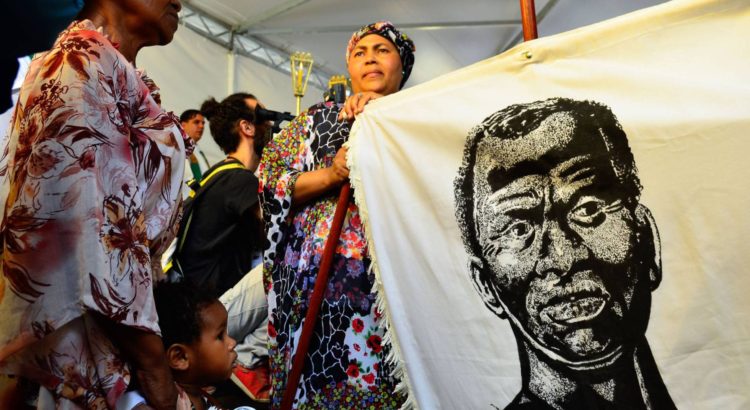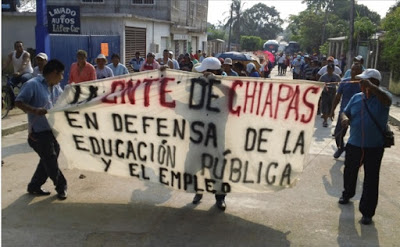Estados Unidos/09 Julio 2016/Autor: Alex Anfruns/Fuente: Investig’action
Inmigración Justa (en inglés BAJI) es una organización de defensa de la justicia racial y los derechos de los inmigrantes negros y los nacionales norteamericanos afroamericanos. BAJI fue creada en 2006 a raíz de las escandalosas propuestas legislativas estatales y nacionales sobre inmigración, con el fin de movilizar a los ciudadanos negros de Estados Unidos y obtener su apoyo al movimiento por los derechos de los inmigrantes. Desde entonces, BAJI ha evolucionado hasta convertirse en una organización con múltiples objetivos de defensa para la población afroamericana en EE.UU., en particular en los ámbitos de la criminalización masiva, la regulación de la inmigración y la desigualdad económica. Lean esta entrevista a Carl Lipscombe, responsable político y legal de BAJI, realizada por Alex Anfruns.
Con motivo del 20 aniversario de la ley de 1996 sobre la inmigración, ustedes han acaban de apelar a la movilización de la opinión en contra de esas leyes. ¿Cuál es el propósito de BAJI?
Nosotros hemos apelado al Congreso para que retire las leyes de 1996. Esas leyes están entre las más duras de los códigos legales estadounidenses. Los textos de Antiterrorismo y de Lucha por la condena no ejecutable de la Pena de Muerte de 1996 (Ley Antiterrorista y de Pena de Muerte Efectiva) amplían los motivos para la detención y expulsión de inmigrantes.
Son también las primeras leyes que permiten los procedimientos comúnmente utilizados en la actualidad de expulsión acelerada. Este texto ilegal de reforma de las leyes de inmigración y sobre los inmigrantes que firmaron pocos meses más tarde (IIRIRA : Illegal Immigration Reform and Immigrant Responsibility Act/IIRIRA: Reforma de Inmigración Ilegal y Responsabilidad del Inmigrante), ha introducido cambios drásticos que permiten expulsiones sobre bases retroactivas. Además, el tipo de delito que podría justificar la expulsión se extiende ahora a los delitos menores como posesión de drogas. No se tiene más en cuenta la confidencialidad de las investigaciones e introduce una nueva serie de motivos en los procedimientos de detención preventiva.
¿Cómo afecta eso a la comunidad negra y a las personas sin papeles?
Más de un no-ciudadano (sin-papeles) de cada cinco, enfrentado a una medida de expulsión sobre bases criminales ante la Oficina Ejecutiva de revisión de la inmigración, es negro. Los inmigrantes negros están más expuestos a los procesos de deportación que la población inmigrante en general.
Mientras que los inmigrantes negros representan sólo el 7,2% de la población que no es ciudadana de Estados Unidos, representan el 20,3% de los inmigrantes que se enfrentan al riesgo de deportación por motivos criminales. Esto se ha de comparar con el 10% del conjunto de todos los inmigrantes que se enfrentan a medidas de expulsión por parte de esa Oficina Ejecutiva de Control de la Inmigración.
Los inmigrantes negros son más susceptibles de ser detenidos por motivos criminales que la población inmigrante en su conjunto. Mientras que los inmigrantes son 3,5 veces más propensos a una detención basada en la violación de las leyes de inmigración que por motivos penales, esta proporción se invierte cuando los inmigrantes son negros.
Los inmigrantes negros están dos veces más expuestos a la detención sobre bases penales. Los inmigrantes negros también están más expuestos que los nacionales de cualquier origen a ser deportados por motivos criminales.
¿Podría exponernos cuáles son los efectos perversos de la retroactividad inducidos por estas leyes?
Implica que una persona que haya cometido un crimen hace años, tal vez décadas antes de que esas leyes fueran aprobadas en 1996, puede ser expulsado en base a ese delito. Aún más, a pesar de que hubiera cumplido la pena de prisión por la falta en cuestión, asimismo puede ser arrestado y deportado.
¿Cuál es la imagen de los inmigrantes negros que transmiten los medios de Estados Unidos?
En EE.UU., los medios de comunicación son una entidad basada en los beneficios. En lo que concierne a nuestra comunidad de inmigrantes negros, no aparece como tal en los medios de comunicación. Estos medios se centran más bien en los países de América Latina, y la inmigración se plantea en el contexto de los latinos de México, de forma que la cara de la inmigración en EE.UU. no es casi nunca la del inmigrante negro.
La lucha de los inmigrantes negros para su reconocimiento por parte de los medios de comunicación apenas está comenzando. Consiste en hacer admitir que en Estados Unidos existen inmigrantes procedentes de países de amplia mayoría negra. Mientras estos inmigrantes negros estén ausentes de los medios de comunicación, también estaremos al margen de la toma de conciencia global del problema. Por lo tanto, los problemas con los inmigrantes negros tienen pocas posibilidades de ser abordados incluso por organizaciones de defensa de los derechos de los inmigrantes, en el seno de las cuales los inmigrantes negros luchan por ser reconocidos.
Nosotros, en BAJI, queremos acercar a algunos de nuestros colaboradores a abordar los problemas específicos de los inmigrantes negros. Porque aunque compartimos lo esencial de esos problemas con los otros inmigrantes, también tenemos problemas más específicos: como la criminalización masiva y sistemática, o el nivel anormalmente elevado de expulsiones a que nos enfrentamos sólo porque somos inmigrantes y negros. Esta es una de las razones por las que BAJI insiste en este punto sobre la información y la educación del gran público, así como el trabajo de comunicación en las redes sociales. Por eso estamos luchando, por el reconocimiento de nuestras comunidades.
¿Qué opina del sistema de prisiones de Estados Unidos y en particular del fenómeno de hacinamiento?
BAJI cree en la abolición de toda forma de encarcelamiento, incluyendo el régimen de aislamiento en celda, la prisión, los centros de detención…
Creemos que las cantidades gastadas en encarcelamientos deben ser gastadas en programas de rehabilitación, consultoría, acompañamiento, formación, educación y vivienda. Eso reforzaría mucho más la seguridad pública.
Traducido del francés por Carles Acózar para Investig’Action
Fuente: http://www.investigaction.net/es/leyes-liberticidas-y-racistas-en-los-ee-uu-congeladas-o-en-curso/#sthash.zNpVfgRP.m04taDNg.dpuf





















 Users Today : 119
Users Today : 119 Total Users : 35419298
Total Users : 35419298 Views Today : 135
Views Today : 135 Total views : 3353426
Total views : 3353426